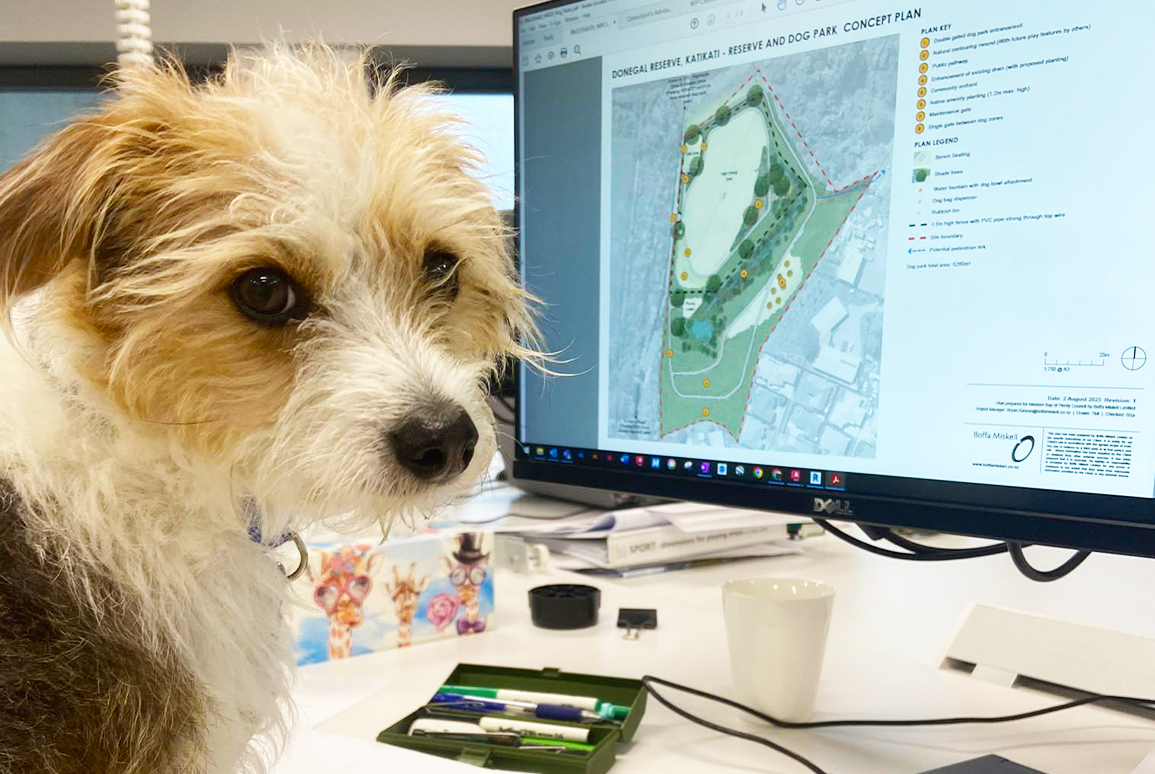Designing parks for Parsnip
17 October 2023
Landscape architect Tessa Milne had a special stakeholder in mind when she designed two outdoor spaces in the Western Bay of Plenty

Earlier this year, Boffa Miskell was approached by the Western Bay of Plenty District Council to design two dog exercise parks – one in Omokoroa and one in Katikati. For graduate landscape architect Tessa Milne this was an opportunity to take a leading role in the design concept.
“These dog parks came out of Council’s review of their dog policy,” Tessa says. “My concepts had to address the constraints of the sites, along with any issues and specifications put forward by the client and the community.
"For each site, we needed to include a securely gated surrounding fence for safety, provision of water for both people and dogs, and a station for poop bags. Other than that, my designs could respond to the site and to what I thought was most appropriate.”

The Links View Reserve in Omokoroa (above) is an oddly-shaped bit of public greenspace in the middle of a residential area, and next to an existing stormwater retention area. Tessa's plan centres on a wide-open space, with smaller places for exploring and sniffing around. A path encircles the park, so owners can walk or run while the dogs play.
“In one corner, a proposed playspace would contain elements like big pipes for the active dogs to run over and through,” says Tessa.
Donegal Reserve in Katikati (below) is a bigger space, off the main road. Here, there’s a large central lawn and a stream that runs along one side and into the dog park to provide water play.
Similar to Omokoroa, there’s a play corner which will have logs to climb around and places for digging. This dog park is part of a larger community space with orchards and picnic tables.
In each reserve, Tessa positioned the ‘high energy zone’ on a diagonal so that it’s at least 90 metres long. This grassy space is designed for ball and frisbee throwing, and for active dogs to exercise. Seating and amenity plantings surround the space, creating a visual border and disguising the 1.5m fence that surrounds each dog park.

The planting palette hasn’t yet been finalised, but karaka trees (Corynocarpus laevigatus) are definitely out of the question. This evergreen native produces a fleshy orange berry that is highly toxic to canines.
“That’s the only tree species that we need to avoid,” says Tessa. “At this point, the plan for the trees is more focused on positioning. Each park has at least one tree near the main entrance for the dogs to mark as they come in, and we’ve got shade trees near the seating areas for people.
“We’d suggest typical native grasses along the boundaries, as a lot of dogs like to run through them and scratch up against them; and a standard lawn-type grass in the middle active areas. If flowering shrubs are needed, I would pick out ones with blue flowers, because they're in the colour spectrum that dogs can see.”
In each park, next to the high-energy zone and accessed through a single gate, there’s a smaller ‘chill zone’ designed with older dogs in mind.
“It’s separated, so senior dogs can wander around or lay in the grass and not have to deal with the rambunctious younger dogs and puppies”, Tessa explains. “There’s more shade in that space, and additional seating for people.”
Principal landscape architect Bryan Sanson signed off Tessa’s design proposal and mentored her through the process.
“These smaller projects are usually a component of a much bigger job,” says Bryan. “In this case, Boffa Miskell and our client (WBoPDC) are redeveloping a number of public recreation areas in the Western Bay of Plenty. Something like these two dog parks are an opportunity for our early career landscape architects to take the lead in the design and experience the whole ‘life-cycle’ of a project first-hand – from consultation through to construction – while being mentored by a more senior designer.”
While Tessa’s concepts reflect the brief from Council and the community, she kept an additional end-user in mind: her own fox terrier/poodle/bichon mix, Parsnip.
“He’s a year and a half old, and he’s an energetic, fun-loving, tennis ball fanatic,” Tessa says. “Parsnip is a smaller dog, but he loves to run around and like any terrier he likes getting into things and digging and exploring.
“At the same time, Parsnip might be a lot more than an older dog wants to deal with, and that’s where the ‘chill zone’ idea came from,” she continues. “There are quite a few of us with dogs here in the Tauranga office – so I was able to get different perspectives and include elements that will suit a variety of sizes and ages, and levels of activity.”
The concepts have been presented to Western Bay of Plenty Council in chambers, and the designs were praised by both the Mayor and the elected members. Council feedback is being incorporated into the plans. Donegal Reserve in Katikati will likely start construction early in the new year, with Ōmokoroa getting underway shortly after.


